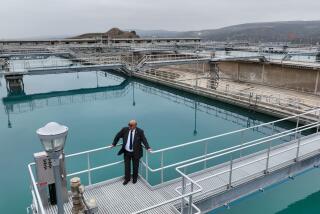Rain Helps O’Connor Repel Storm of Criticism : Drought: The San Diego mayor was chastised for opposing mandatory rationing in her city. With a little help from above, she claims vindication.
SAN DIEGO — One month ago, San Diego Mayor Maureen O’Connor risked the reputation of her native city in a high-stakes gamble on the elements.
As the rest of San Diego County and the region adopted mandatory conservation measures in response to the drought, she alone stuck with voluntary methods. Her civic-minded constituents, she said, would rise to the occasion and conserve 30%.
In the ensuing weeks, she was embarrassed by revelations about her own water consumption: The Times discovered a second, previously unacknowledged water meter on her property that placed her among the city’s top 100 residential water users. She was ridiculed, painted by cartoonists as a naive, hypocritical zealot and chastised by one Los Angeles water official as obnoxious and insensitive.
But as the month draws to a close, O’Connor says she’s been right all along. It has rained 12 of the last 29 days, depositing nearly 7 inches of water and making this San Diego’s second-wettest March on record. The city of San Diego has met its 30% conservation goal. And the County Water Authority has opted to delay its call for 50% cuts--an action that O’Connor says has “vindicated” her stand.
State and local water experts have said repeatedly that while immediate deliveries to Southern California are likely to improve slightly as a result of the rain, the drought is far from over. The county water authority made it clear that its action in no way signaled the end of the drought, and merely delayed a decision until April 15. And in San Diego, which relies on piped-in water for 95% of its supplies, there are no storage facilities to catch that prolific rainwater for use in the long run. When it stops raining, residents are expected to feel the pinch.
But none of that has stopped O’Connor from declaring victory. Nor has it stopped some observers from calling this the mayor’s Miracle March.
“Heavenly intervention is where she’s one up on me. If she pulls off one more miracle, I’m going to convert to Catholicism,” said former City Manager John Lockwood, a Methodist, who publicly questioned whether voluntary conservation could achieve 30% cuts shortly before he retired this month. “I’ll never contest her again. If she says it’s going to snow on Mt. Helix (a residential hillside area), by gosh, I’ll get my skis out.”
“It takes tremendous courage to put your neck out like that,” said Councilman Bruce Henderson. “She was lucky it did rain hard. But in truth it wasn’t luck, it was a willingness to go to the nth degree to make sure people’s jobs aren’t lost.”
Said O’Connor: “They literally threw the kitchen sink and my house meter at me. The people do want to stand up and be counted. I don’t care what they’re saying about San Diego up and down the state. I’m proud to be your mayor.”
There is good-natured debate over whether the mayor’s good fortune is a product of serendipity, religion or educated guesswork. But there is agreement on this point: The last month has been the ultimate test of her good-luck streak, and she’s put it to good advantage.
At the end of February, as the first heavy rain in months began to fall, the mayor “strongly” suggested what other cities had required for months: San Diegans should turn off their sprinklers.
Mike Gage, the president of the board of the Los Angeles Department of Water and Power, was quoted as widely criticizing the mayor. He lamented what he called San Diego’s “fairly obnoxious disregard for their fellow Southern California cities.”
The next day, O’Connor telephoned Gage and introduced herself as “the wicked witch of the south.” She made an appointment to correct Gage’s “misperceptions” and arrived armed with charts showing that San Diegans had conserved 34% during the first 11 days of March, while Los Angeles residents had cut back only 25%.
At a news conference in San Diego, the mayor made a prediction: “I’m beginning to think that the weather is a-changing, and you might be seeing the tail end of the drought, even though there isn’t anybody in the state that seems to want to admit that today.”
Evidently inspired by this statement, a San Diego Tribune cartoonist drew the mayor dressed in long robes holding a sign that said, “The Drought Will End Today.”
As it turned out, the mayor had an adviser on local rainfall--a meteorologist named Harold Throckmorton who teaches at Mesa College with O’Connor’s sister, Colleen. Throckmorton did not claim to be one of the region’s leading weather experts. In fact, he said he got a lot of his weather information secondhand, from the cable Weather Channel and the National Weather Service.
But he had a hunch--a “gut feeling,” he called it--that March was going to be a refreshingly wet month. The mayor took that hunch and ran with it.
She didn’t get far, however, before it was discovered that she and her husband had consumed more than twice as much water as she had previously acknowledged. Because of a second meter on the mayor’s Point Loma property, more than half of her household’s water use had gone unnoticed for months.
The scandal became known as “water-gate” and now, a few weeks later, the jokes have begun. At an America’s Cup luncheon at the San Diego Convention Center last week, the emcee told the 800 guests that the door prize would be “a guided tour of Mayor O’Connor’s water meters.”
More to Read
Sign up for Essential California
The most important California stories and recommendations in your inbox every morning.
You may occasionally receive promotional content from the Los Angeles Times.









